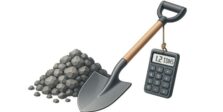Calculate the exact amount of gravel, river rock, and crushed stone you need for your landscaping project. Our free calculator provides accurate estimates in tons, cubic yards, and bags, helping you avoid ordering too much or too little material. Whether you’re building a driveway, walkway, garden bed, or drainage system, this tool accounts for compaction, waste factors, and material density to give you professional-grade calculations.
How Much Rock You Need — Instantly Calculated!
Accurate material estimation for landscaping and construction projects
Project Setup
Material Selection
Cost Estimation (Optional)
Your Results
Enter your project dimensions to see results
Application Guide
Driveways & High Traffic
Use 3/4″ crushed stone (#57), 4″ depth minimum. Compact well for stability.
Walkways & Paths
Pea gravel or decomposed granite, 3″ depth. Comfortable underfoot.
Drainage & Erosion
Larger river rock or riprap, 3-4″ depth. Allows water flow.
